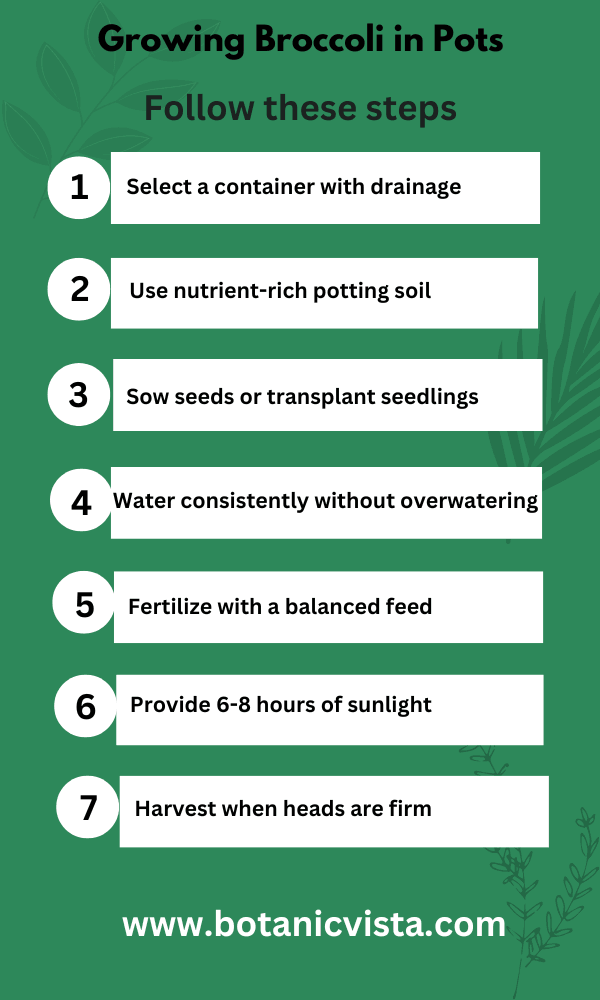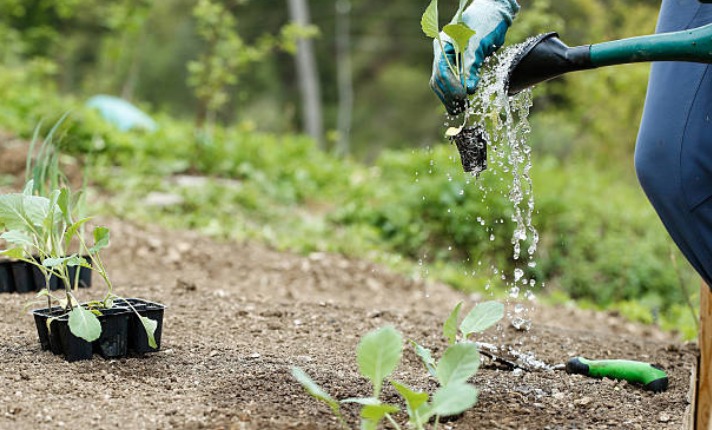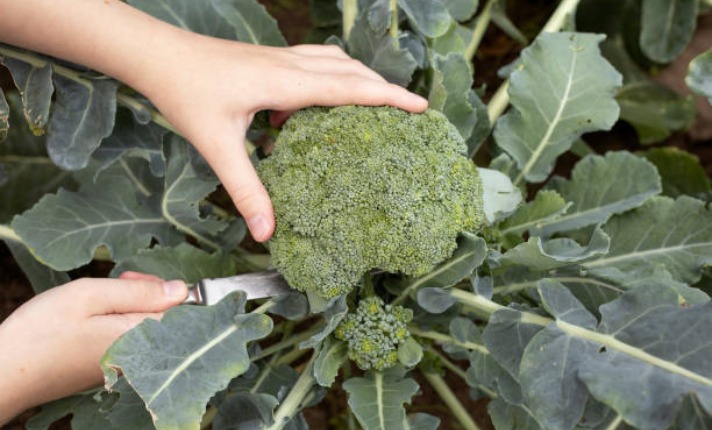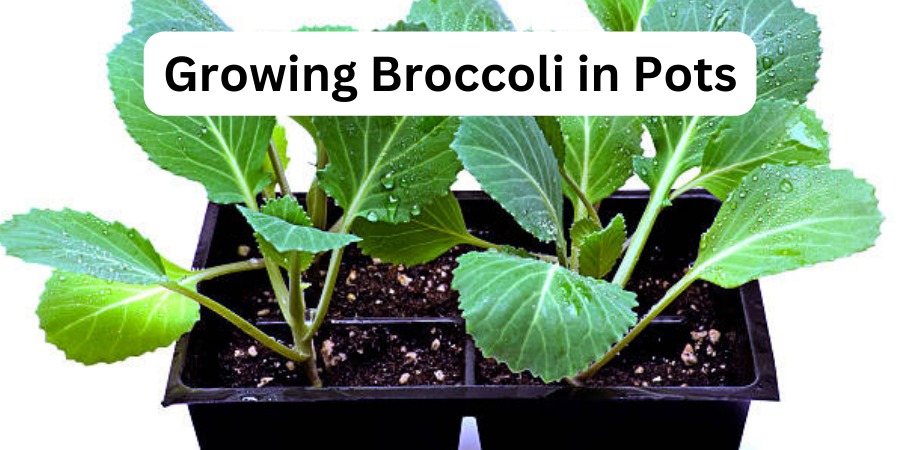Last Updated on October 11, 2024 by Jocelyn
Growing broccoli in pots is a dream for many gardeners with limited space. It’s possible to enjoy home-grown broccoli even if you only have a balcony or windowsill. With the right container and care, you can harvest nutritious florets packed with vitamin C and minerals.
Broccoli, a member of the Brassica oleracea family, is known for its tree-like structure and dark green heads. This cool-weather vegetable grows well in controlled environments and can be planted in spacious pots, producing a bounty of florets.
By using Hybrid varieties like Tenderette or Purple Sprouting, you can maximize your space and boost your garden’s productivity.
Enjoy plucking fresh broccoli from your patio for dinner, knowing it’s rich in vitamins and minerals. In this article, we will cover a comprehensive step-by-step guide on selecting the best containers, choosing the right variety, and maintaining the ideal growing environment.

Table of Contents
ToggleUnderstanding Broccoli and Its Varieties
Broccoli is a vegetable enjoyed around the globe. It belongs to the Brassicaceae family and has been cultivated in Italy for over 2,000 years. Broccoli, scientifically known as Brassica oleracea.
It’s an annual plant, meaning it completes its life cycle in one growing season. It is known for its edible heads and stems. There are different broccoli types to choose from, each with unique traits, which make it suitable for various gardening plans.
Popular Varieties for Indoor Container Gardening
| Variety | Traits | Maturity |
| Royal Tenderette Hybrid | High-yielding variety with compact growth and fast maturity. Produces large heads with a flavorful taste. Ideal for quick harvests. | 55 days |
| Tenderstem Broccoli | Hybrid between broccoli and Chinese broccoli. Known for tender stems and suitable for multiple harvests. Grows quickly. | 50-60 days |
| Purple Sprouting Broccoli | Hardy type suited for cooler climates. Features purple shoots. Can be grown in pots and takes longer to mature. | 200 days |
| Calabrese | Traditional broccoli type with large heads and smaller side heads. Good for extending harvest periods. | Varies |
| Broccolini | Cross between traditional broccoli and Chinese broccoli. Noted for its tender stems and versatility in dishes. | Varies |
For more insights on growing in pots, check out my guides:
Preparing for Indoor Planting
Growing broccoli in pots is a great way to enjoy fresh vegetables at home. Let’s look at how to set up the perfect indoor garden.
Choosing the Right Container
- Broccoli Container Size
Choose a container that is deep and wide enough to support the root system of your broccoli. Ideally, it should be at least 12-18 inches deep and wide to allow for healthy growth.
- Material Considerations
When selecting containers, consider plastic, clay, ceramic, wood, and fabric pots. Plastic pots are lightweight and retain moisture well, but they can become brittle over time. Clay and ceramic pots provide good insulation but dry out faster. Fabric pots promote healthy root development but require more frequent watering.
- Drainage Requirements
Ensure your container has adequate drainage holes. This prevents the soil from becoming waterlogged, which can lead to root diseases. Proper drainage is crucial for maintaining healthy plants.
Selecting the Right Soil
- Soil Composition
The soil in your container should be a good potting mix rich in organic matter. A mix containing compost, coconut coir, perlite, and vermiculite is ideal for retaining moisture without becoming soggy.
- Soil pH and Fertility
Maintain a soil pH between acidic and neutral for optimal broccoli growth. Adding fertilizer to your potting soil ensures that your plants get the necessary nutrients. Regularly check the soil pH to keep it balanced.
Sowing and Planting Broccoli indoor
Growing broccoli in pots is a great way to enjoy fresh vegetables at home. With a few simple steps, you can have a healthy crop. Let’s start with selecting the right seeds and sowing them properly. Next, we will move on to transplanting seedlings.
Sowing Broccoli Seeds
Choose deep purple-brown seeds that look like peppercorns. These seeds will grow best. First, use a seed-starting mix in seed trays or small pots. Place the seeds in moist soil. Keep the soil from getting waterlogged. Soon, you will see seedling sprouting.
Transplanting Broccoli Seedlings
Once the seedlings have true leaves beyond the cotyledons, they are ready for transplanting. Make sure the soil is firm and dig a hole for the roots and stem. Use a nitrogen-rich fertilizer to help them grow.
Before moving the seedlings outside, harden off by slowly exposing them to outdoor conditions. This will prepare them for the garden.

Growing Broccoli Indoors from Stem or Without Seeds
Growing broccoli indoors from stems can be quite fulfilling. Start by cutting a healthy broccoli stem about 6 inches long. Place the stem in a glass of water, making sure the bottom is submerged. After a few days, roots will begin to form. Once the roots are about 2 inches long, transfer the stem to a pot filled with rich soil. Keep the soil moist and place the pot in a sunny spot.
Growing broccoli at home without seeds involves alternative propagation methods. One effective method is using broccoli stems. Select a fresh stem and place it in a jar with water. Change the water every two days to keep it fresh. Once the roots are visible and strong, plant the stem in a pot with good quality soil. Ensure the pot has proper drainage.
To learn more about indoor gardening, check out my guides:
Caring for Growing Broccoli in Pots
Caring for growing broccoli in pots requires a few key steps. Regularly check the soil’s moisture and ensure the plants get enough sunlight. Maintain a suitable temperature range and monitor for pests and diseases. Prune and stake the plants as needed to support their growth. With these practices, your broccoli plants will stay healthy and productive.
Watering
Frequency and Methods: Water your broccoli plants regularly to keep the soil moist, but not waterlogged. Check the soil frequently to ensure it stays evenly moist. Avoid overwatering by making sure the soil is not too wet.
Avoiding Overwatering: Be careful not to overwater your plants. Water when the top inch of soil feels dry. Overwatering can cause roots rot and lead to diseases.

Fertilizing
Types of Fertilizers: Use organic fertilizers like compost or a balanced nitrogen-rich fertilizer. Fertilizers with the right nutrients are important for healthy growth.
Application Schedule: Apply fertilizers every two weeks. Follow the package instructions for the right amount. Over-fertilizing can harm the plants.
Light and Temperature Requirements
Optimal Light Conditions for Indoor Growth: Place the pots in a sunny spot, like a south-facing window. Broccoli plants need at least six hours of sunlight daily.
Temperature Tolerance: Keep the temperature between 60°F and 70°F. Cooler temperatures are fine, but avoid extreme heat. Indoor environments can help manage this.
Pest and Disease Management
Common Indoor Pests and Diseases: Look out for aphids, cabbage loopers, and beetles. Pests can damage the leaves and stems. Diseases like mildew can also appear.
Organic and Chemical Control Methods: Use neem oil or soapy water to treat pests. Garlic and rosemary can act as natural repellents. Check plants regularly for signs of pests and diseases.
Pruning and Staking
When and How to Prune: Prune the plants by pinching off the shoots and removing broken or damaged leaves. Pruning helps the plants grow healthily and prevents them from becoming too large.
Supporting Plants with Stakes: Use stakes to support the stems if they grow tall. This keeps the plants upright and helps them grow strong.
Harvesting Broccoli
When harvesting broccoli, look for a central head that is tight and firm. Cut the head along the stem using a sharp knife.
Broccoli heads are usually ready to be harvested in about 4-7 weeks after planting. After the initial head is cut, side shoots will continue to produce smaller heads. Keep the plants watered and free from pests to ensure a healthy crop.
For the best flavor, harvest before the buds flower. Home-grown broccoli is more delicious and tender than store-bought. Store your fresh broccoli in the refrigerator to keep it crisp.
Growing hybrids can provide a more consistent yield. A plastic container with a diameter of at least 15 inches is ideal for one plant. Separating the plants by 2-4 weeks can extend the harvesting cycle.
Enjoy your broccoli in a stir-fry, soup, or roasting it for a hearty meal. The satisfaction of growing and eating your own broccoli is a journey worth taking!

FAQ’s
Q: Does Broccoli Grow Better in Sun or Shade?
A: Broccoli grows best in full sun for at least six hours a day. In hot climates, partial shade in the afternoon can prevent bolting and support healthy growth.
Q: Does Broccoli Need a Trellis to Grow?
A: Broccoli doesn’t necessarily need a trellis to grow, but using a support can help them stay upright. Some gardeners use stakes to help their plants, similar to how peppers and zucchini are often supported. This kind of support can benefit broccoli, especially in windy areas.
Q: What is the best fertilizer for broccoli?
A: Broccoli needs nutrients to grow strong. Fish emulsion is a good fertilizer, releasing nutrients slowly. Compost improves soil structure, while blood meal or fish meal boosts plant health. Use organic options for sustainability.
Q: What Is the Lifespan of Broccoli?
A: Raw broccoli lasts 5 to 7 days in the refrigerator. Cooked broccoli stays good for 3 to 5 days in the fridge. When properly blanched and frozen, it can last up to 12 months in the freezer.
Q: How Many Heads of Broccoli Do You Get From One Plant?
A: A broccoli plant produces one large central head, which is the main head and is harvested first. After this, smaller heads emerge from the leafstalks, allowing each plant to continue producing florets.
Conclusion
Growing broccoli in pots is a great way to enjoy fresh, home-grown vegetables, even with limited space. Choose the right containers and understand your plants’ needs. Provide proper care and attention. This journey requires preparation, patience, and overcoming challenges. With helpful tips, you can harvest nutritious broccoli heads. Container gardening is versatile and accessible for both beginners and seasoned gardeners. Monitor for pests and diseases, water regularly, and enjoy your garden on a sunny balcony or well-lit indoor space.

